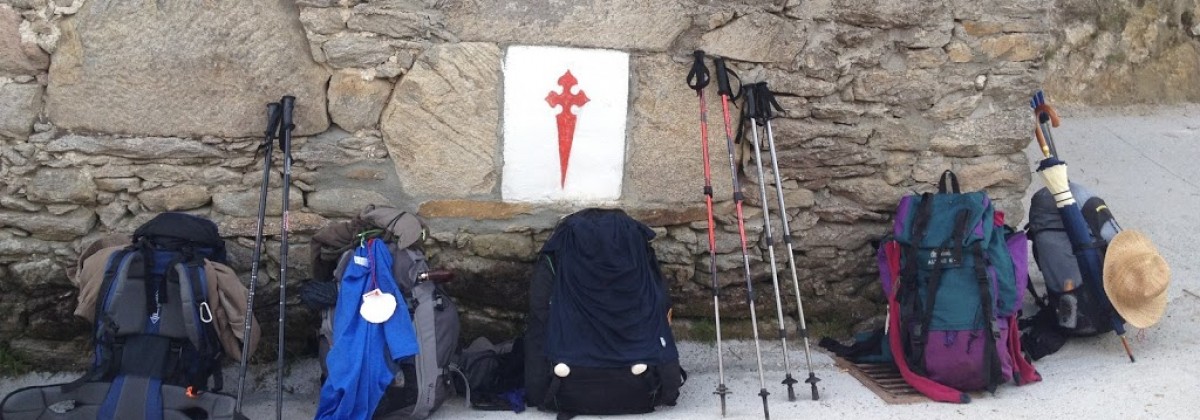 on day 10 we crossed into the third — and largest — autonomous region on our Camino: Castilla y León. encompassing over 94,000 square kilometers and (in 2011) home to 2.5 million people, it is the largest region in Spain. because the governments are autonomous, each offers slightly different aides for peregrinos — maps, directional markers, municipal albergues. the maps in Castilla y León were perhaps the most useful and comprehensive, though found less frequently than in Galicia, for example. as you can see, it includes all the tiny towns along the Camino, as well as noteworthy sights, plus distances listed by the stages of the medieval method of Camino demarcation — the Codex Calixtinus (about which more soon).
on day 10 we crossed into the third — and largest — autonomous region on our Camino: Castilla y León. encompassing over 94,000 square kilometers and (in 2011) home to 2.5 million people, it is the largest region in Spain. because the governments are autonomous, each offers slightly different aides for peregrinos — maps, directional markers, municipal albergues. the maps in Castilla y León were perhaps the most useful and comprehensive, though found less frequently than in Galicia, for example. as you can see, it includes all the tiny towns along the Camino, as well as noteworthy sights, plus distances listed by the stages of the medieval method of Camino demarcation — the Codex Calixtinus (about which more soon).
the climate and geography Castilla y León differ quite dramatically from the preceding and subsequent regions and, thinking back, I’m rather surprised at how quickly the change occurred. whereas rolling hills characterize Rioja and Navarra, the terrain of Castilla y León primarily consists of and largely constitutes Spain’s Meseta Central, an arid, mostly flat, high plain with elevations between 610 and 760 meters. basically, it was very flat with the occasional steep mesa or small hill. mountain ranges border and divide Castilla y León into smaller regions; thankfully, for the most part we got to enjoy the mountain views from afar rather than while climbing over ranges. because its buffered on all sides by mountain ranges, the region remains quite arid though, because of its size, temperatures and precipitation vary dramatically. in the central areas, fewer than 18 inches of rain might fall a year while to the west upwards of 59 inches might fall.
as one might deduce, the roots of Castilla y León lie in separate kingdoms of the middle ages. the name of the former comes from the castles and forts built to defend the kingdom’s eastern border (similar to those discussed in previous posts) and was first referenced in 800. over the next century and a half the kingdom was periodically divided and reconstituted until, through the rebellion efforts of Count Fernán González , the kingdom was unified into an autonomous entity in 931 that no longer paid vassalage to León.
this independence was short lived as a series of political machinations-via-marriage, untimely deaths, and brotherly feuds brought the two kingdoms under the same crown for a brief period during the reign of Ferdinand I. his death in 1065 resulted in division of territories among sons, fighting between said sons, more reunification, more divisions, more fighting, and so on into the 13th century. Alfonso VII divided the territory between his two sons (Sancho III got Castilla; Ferdinand II, León). the two factions finally joined permanently when in 1230, after having assumed the throne of Castilla in 1217 through his mother, Ferdinand III assumed the throne of León through his father Alfonso IX.
 León was formed when Alfonso the Great (III of Asturias) divided his land among his three sons, with Galicia, León and Asturias going to Ordoño II, García I, and Fruela II, respectively. Ordoño II’s successor, Ramiro II worked ardently to push back Muslim incursions, successfully driving them back from previously-settled territory and establishing a no-go area along the Duoro river valley that divided northern Christian-held territory from Muslim-held territory on the southern Iberian peninsula.
León was formed when Alfonso the Great (III of Asturias) divided his land among his three sons, with Galicia, León and Asturias going to Ordoño II, García I, and Fruela II, respectively. Ordoño II’s successor, Ramiro II worked ardently to push back Muslim incursions, successfully driving them back from previously-settled territory and establishing a no-go area along the Duoro river valley that divided northern Christian-held territory from Muslim-held territory on the southern Iberian peninsula.
despite Alfonso IX best intentions, the unification of Castilla and León under one crown remains a contentious issue. the people of León did not take the increasing dominance Castilla well and, even today, we saw lots of anti-Castillian sentiment in the western part of the region. (throughout Astorga, for example, someone had gone around town and spray-painted out the “Castilla” part on governmental signs.) despite the royal centralization, the regions retained separate languages, currencies, flags, laws, and governmental systems until Spain centralized its government in the modern era, though by the 16th century Castilla had assumed majority control and León was, in practice, a captaincy-general. (fun fact: in 19th century, the Kingdom of León joined Galicia and Asturias to declare war on France — presumably against Napoleon.)
and all of this is to say that Castilla y León is big. the biggest region we walked through by a long way and despite the unity one might infer by the name, reality is somewhat different. researching all this has put that portion of the Camino into a different perspective for me — at the time it seemed dully monotonous because the terrain remained relatively static; but it turns out there’s a rich socio-political history to uncover. just took a little digging.

